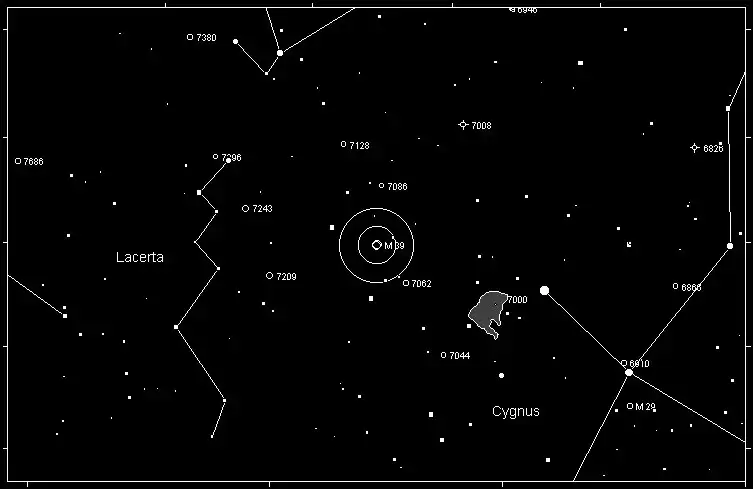Messier 39 (M39) is an open star cluster located in the constellation Cygnus. Situated at a distance of approximately 825 light-years from Earth, M39 is a relatively close and bright cluster in our night sky. The cluster contains around 30 stars spread across an area of the sky that is about as large as the full Moon, making it an easy target for amateur astronomers. M39's stars are young, blue-white stars that are roughly 300 million years old, and the cluster spans about 7 light-years across.
Magnitude: M39 has an apparent magnitude of 4.6, making it visible to the naked eye under dark skies. However, with the help of binoculars or a small telescope, the individual stars of the cluster become more distinguishable, allowing for a more detailed observation of this beautiful open cluster.
Season for Observation
M39 is best observed during the summer and early autumn months in the Northern Hemisphere. The cluster becomes prominent in the evening sky from July to October, with August and September offering optimal viewing conditions as it reaches its highest point in the sky.
Constellation
M39 is located in the constellation Cygnus, also known as the Swan. Cygnus is one of the most recognizable constellations in the summer sky, featuring the bright star Deneb, which forms part of the Summer Triangle along with Vega in the constellation Lyra and Altair in Aquila.
How to Find Messier 39
To locate M39, first find the constellation Cygnus. The easiest way to do this is to look for the "Northern Cross," a distinctive asterism formed by five stars: Deneb (the tail of the swan), Albireo (the head), and three stars that form the wings of the swan.
Once you've identified Cygnus, locate the star Deneb, the brightest star in the constellation. M39 is about 9 degrees to the northeast of Deneb. If you extend an imaginary line from the star Sadr (which forms the center of the cross) toward Deneb and continue in the same direction, you’ll reach M39. Binoculars or a wide-field telescope will show the cluster's stars as a sprinkling of faint dots across the sky.

History
Messier 39 was discovered by the French astronomer Charles Messier in 1764. Messier was known for his catalog of "nebulae and star clusters" that appeared as faint, cloudy objects in the night sky, often confusing comet hunters. His catalog, now known as the Messier Catalog, contains some of the most famous deep-sky objects visible from Earth, and M39 holds the 39th position in this collection.
M39 was one of the easier objects for Messier to identify, given its brightness and proximity to other well-known celestial landmarks in Cygnus. The stars of M39 are relatively young compared to other open clusters, and because of their youth, they are still bound together loosely by gravity. Over time, these stars will continue to drift apart, eventually dispersing into the surrounding interstellar medium.
Conclusion
Messier 39 is a delightful target for both novice and seasoned astronomers alike. Its proximity, brightness, and position in the easily recognizable constellation Cygnus make it a popular object during summer and fall observing sessions. Whether viewed through binoculars or a small telescope, M39 offers a glimpse into the youth of our galaxy, showcasing stars that have not yet ventured far from their birthplace in the cosmic nursery of the Milky Way.
